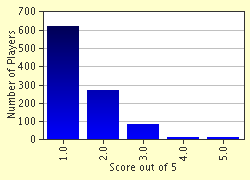Quiz Answer Key and Fun Facts
1. Read carefully and draw the correct conclusion from this premise (which is assumed to be true for this question):
If no head injury is too trivial to be neglected, then...
2. Only one of the following sentences cannot be disambiguated to parse as a grammatical, meaningful sentence in English, using standard grammatical rules. Which one is the non-grammatical sentence?
3. Consider this simple syllogism. '(1) All artists are beekeepers. (2) Some beekeepers are chemists.' If (1) and (2) are both true, then which of the following must be true?
4. Three cards are in a hat. One is red on both sides, one is white on both sides, and one is red on one side and white on the other. I close my eyes, draw a card from the hat, and drop it on the table. Then I open my eyes and see that the upward-facing side is red. What is the probability that the downward-facing side is also red?
5. Tom, Dick and Harry are in prison. One of them has been randomly selected to die in the morning, and the other two will be set free. Their guard knows which one will die, but none of the prisoners does. The guard is under strict instructions not to divulge the identity of the doomed man. Tom is desperate for any information beyond the fact that his probability of death is one in three. He begs the guard to throw him an informational bone. Finally, to shut him up, the guard agrees to reveal only the following: the name of one of Tom's fellow prisoners who will be set free rather than killed. The guard then says that Dick will be set free. After receiving this information from the guard, what is the most accurate calculation Tom can make of the probability that he is the doomed man?
Note that the guard has never met Tom, Dick or Harry before - he has no preference for any of them. He merely names one person he knows will not die.
Hint: This problem is very closely related to the Monty Hall problem.
Source: Author
xaosdog
This quiz was reviewed by FunTrivia editor
spanishliz before going online.
Any errors found in FunTrivia content are routinely corrected through our feedback system.

